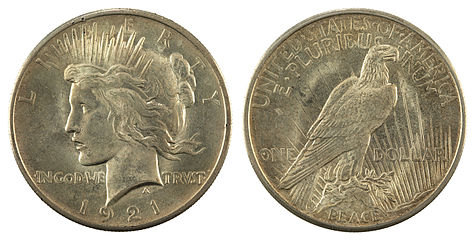The Comstock Lode was discovered in 1859. At the time it was the largest silver mine in the world. Thousands of people flocked to region, quickly leading to the Nevada Silver Rush. The ease and accessibility of high purity silver ore close to the surface led to a huge amount of silver saturating the markets.
During this time, the Coinage Act of 1873, or the Crime of 1873, moved the economy off a bi-metalic standard to a pure gold standard, effectively de-monetizing silver. This dealt a significant blow to silver miners and the economies of silver-producing states like Nevada.
After a tremendous lobbying effort by miners and others in the silver industry, the Bland-Allison Act was signed into law in 1878, returning the economy to a bi-metalic standard. The Bland-Allison required the Treasury to purchase a certain amount of silver each month to be coined into silver dollars. This created an immediate demand for silver and stimulating the economy of states where mining was active.
Throughout this era the Treasury had minted millions of Morgan silver dollars and had still stockpiled an overwhelming amount of raw material. The minting of the Morgan was halted in 1904.
How Much is a Peace Silver Dollar (1921-1935) Worth?
The US Congress passed The Pittman Act after the end of the first World War which authorized reestablishing a one dollar coin. Initially, the US Mint began minting the Morgan Dollar in 1921 which had not been minted since 1904.
During this time many in Congress and the Treasury were interested in replacing the design of the Morgan Dollar with one that was more symbolic of the peace reached at the end of World War I. In 1921, then Treasury Secretary Andrew Mellon, approved the design of the Peace Dollar.
The minting of the Peace Dollar coin began in 1921 and ended in 1935. The coins were struck at all three primary US Mint facilities, Philadelphia, Denver and San Francisco. The mintage numbers from each facility were varying each year.
Peace Dollar Design
The Peace Dollar was designed by Italian-American sculpture Anthony (Antonio) de Francisci. At only 34 years old at the time of the design competition, de Francisci was the youngest of all of the sculptures competing.
The obverse of the Peace Dollar features the head and neck of the Goddess Liberty. Her profile depicts flowing hair with a radiant crown on her head. The coin’s obverse also features the phrase “In God We Trust” and the word “LIBERTY” across the top edge with the year of minting being inscribed below.
The reverse of the Peace Dollar features a sitting eagle at rest, symbolic of the strength and influence of the United States throughout the world, clutching an olive branch, a recognized symbol of peace. The bald eagle is high atop a perch with rays of sunlight radiating in the background. The word “Peace” is inscribed on the lower edge of the reverse, with the inscription “UNITED STATES OF AMERICA,” “E. PLURIBUS UNUM” along the top edge, and the phrase “ONE DOLLAR” stretching on either side of the center of the coin.
Peace Dollar Mint Marks
The mint mark on the Peace Dollar is on the coin’s reverse located above tip of eagle’s wings. Coins which were produced by the Philadelphia Mint lack an identifiable mint mark. Coins produced at the Denver Mint will show a “D”. While Peace Dollars minted at the San Francisco Mint will show an “S” mint mark.
Peace Dollar Popularity Amongst Collectors and Investors
The Peace Dollar is popular with both collectors and investors for a variety of reasons.
Collectors see the coin with historical significance given when it was released and the reasons and symbolism inherent with it’s design. The earliest versions of the Peace Dollar are nearly 100 years old.
Investors see both the intrinsic value of the composition of the Peace Dollar, which is compromised of 90% Silver. Investors also see the historical significance to the collectors which helps to keep the secondary market premiums for Peace Dollars higher than just their melt value.
It’s common to buy circulated silver coins that were minted prior to 1965 for a small premium over their melt value. However, Peace Dollars and other 90% silver dollar coins are often sold at a higher premium, even for coins that are in cull condition.
